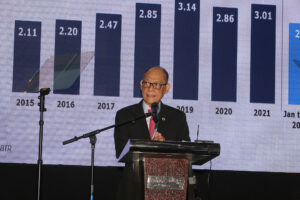By Luisa Maria Jacinta C. Jocson, Reporter
PROJECTS financed by the Maharlika Investment Fund (MIF) will be at reduced risk of administrative and legal challenges, with official development assistance (ODA) also becoming harder to access, Finance Secretary Benjamin E. Diokno said.
“Financing through the GAA (General Appropriations Act, or the national budget) is lengthier and risky since this is subject to political review and approval. The official development assistance (ODA) and private-sector solicited and unsolicited proposals are by nature, time consuming, subject to lengthy negotiation and court challenges, and more careful appraisal,” Mr. Diokno told reporters in a chat message on Sunday.
The fund “will provide an additional source of financing for, and possibly speedier implementation of government priority projects,” he added.
He said mass transit systems, power grid distribution, renewable energy, and waste-to-energy projects were among the priority projects being contemplated by the government.
“The Philippines will soon graduate to be an upper middle-income country, and as such will cease to be eligible for the relatively less expensive ODA which is only available to less developed countries. In brief, the Philippines has to develop alternative sources of financing for its priority projects as ODA financing dries up,” he added.
The Philippines hopes to reach upper-middle income status by 2025. It is currently classified as a lower middle-income country by the World Bank.
Gross national income (GNI) per capita was P188,939 or a little over $3,500 in 2022, up 3.6%.
The World Bank classifies those with a GNI of $4,256 to $13,205 as upper middle-income countries.
This year, the National Government is seeking to obtain $19.1 billion worth of ODA, consisting of $9.2 billion worth of loans from multilateral development partners and $9.8 billion in loans from bilateral lenders.
Mr. Diokno said Maharlika’s initial capital will not come from dividends provided by government-owned and -controlled corporations (GOCCs).
He said Maharlika will have at least $5 billion worth of initial funding, including P100 billion from the Bangko Sentral ng Pilipinas (BSP).
“That’s 100% of (the bank’s) net income for two years and 50% for the succeeding year. The gross international reserves won’t be touched,” Mr. Diokno said.
“BSP Governor Felipe M. Medalla acknowledged that the BSP is in a good financial state. He categorically said that BSP can afford to gradually increase its capitalization from P50 billion to P200 billion. In fact, at the height of the COVID-19 pandemic, the BSP declared a substantial dividend in favor of the NG, much higher than any GOCC, though it was not required to do so by law,” he added.
Other financing sources are Land Bank of the Philippines (LANDBANK) with P50 billion or 3.8% of its P1.3 trillion investible funds; the Development Bank of the Philippines (DBP) with P25 billion or 3.1% of its P800 billion in investible funds, and privatization proceeds equal to P100 billion that could potentially rise to P150 billion.
“Since the MIF can only be used for investment in infrastructure projects approved by the NEDA Board, I’m sure both investments by the LANDBANK and the DBP will give a higher return on investment compared to what both institutions are getting right now,” he added.
He also cited other potential sources of funds, such as foreign-exchange denominated infrastructure bonds and royalties from the mining sector.
“As new sources for large priority projects are developed, the fiscal space of the National Government will widen. This means more resources of the government might be allocated for investment in human capital and social protection,” Mr. Diokno said.
“As a result of the scarring effect of the pandemic, upskilling and retraining of our young population have high social and economic payoff. In an aging world population, our young people — tech-savvy, easily trainable, and mostly English speaking — are our most formidable asset,” he added.
